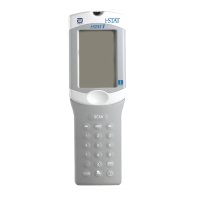PROCEDURE MANUAL FOR THE i-STAT SYSTEM
4
REV. DATE: 16-Oct-12 ART: 714446-00L
Suitable Specimens for BNP
EDTA whole blood plasma samples collected in plastic syringes or evacuates tubes containing EDTA. Fill
collection tubes to capacity.
Specimen Labeling
Unless the specimen is analyzed immediately after collection and then discarded, the specimen container must be labeled
with the following information:
Patient name, sex, age
Patient ID number
Time and date of collection
Phlebotomist ID
Doctor’s name
Specimen Collection and Handling
In-Dwelling Line
Back flush line with sufficient amount of blood to remove intravenous solution, heparin, or medications that may
contaminate the sample. Recommendation: five to six times the volume of the catheter, connectors, and needle. If collecting
sample for ACT, clear the line first with 5mL saline and discard the first 5mL of blood or six dead space volumes of the
catheter.
Arterial Specimens
For cartridge testing of blood gases, electrolytes, chemistries, and hematocrit, fill a plain syringe or fill a blood gas syringe,
labeled for the assays to be performed, to the recommended capacity, or use the least amount of liquid heparin anticoagulant
that will prevent clotting. Under-filling syringes containing liquid heparin will decrease results due to dilution and will
decrease ionized calcium results due to binding. For ionized calcium, balanced or low volume heparin blood gas syringes
should be used. Do not expose sample to air or PCO
2
may decrease, pH may increase and PO
2
may decrease if the value is
above or increase if the value is below the PO
2
of room air (approximately 150 mmHg).
For cartridge testing of ACT, use only a plain, plastic syringe without anticoagulant.
Mix blood and anticoagulant by rolling syringe between palms for at least 5 seconds each in two different directions, then
invert the syringe repeatedly for at least 5 seconds. Discard the first two drops of blood. For blood gas testing, avoid or
remove immediately any air drawn into syringe to maintain anaerobic conditions.
Test samples collected without anticoagulant immediately. Test samples for ACT and lactate immediately. For pH, blood
gases, TCO
2
and ionized calcium, test within 10 minutes of collection. If not tested immediately, remix the sample and
discard the first two drops of blood from a syringe before testing. Note that it may be difficult to property remix a sample in
a 1.0 cc syringe. For other cartridge tests, test sample within 30 minutes of collection.
Venous Specimens
For cartridge testing of electrolytes, chemistries, and hematocrit, collect sample into an evacuated blood collection tube or a
syringe containing sodium, lithium, or balanced heparin anticoagulant. For ionized calcium measurements, balanced heparin
or 10 U of sodium or lithium heparin/mL of blood is recommended. Fill tubes to capacity; fill syringes for correct heparin-to-
blood ratio. Incomplete filling causes higher heparin-to-blood ratio, which will decrease ionized calcium results and may
affect other results. The use of partial – draw tubes (evacuated tubes that are adjusted to draw less than the tube volume, e.g.
a 5 mL tube with enough vacuum to draw only 3 mL) is not recommended for blood gas or CHEM8+ cartridges because of
the potential for decreased PCO2, HCO
3
and TCO
2
values.
For cartridge testing of ACT or PT/INR, use only a plain, plastic syringe or collection tube containing no anticoagulant. Use
a plastic capillary tube, pipette, or syringe to transfer sample from a tube to a cartridge.
For glucose cartridge testing, EDTA is also an acceptable anticoagulant. EDTA is the only acceptable anticoagulant for
BNP Cartridge testing.
Mix blood and anticoagulant by inverting a tube gently at least ten times. Roll a syringe vigorously between the palms for at
least 5 seconds each in two different directions, then invert the syringe repeatedly for at least 5 seconds, then discard the first
two drops of blood. Note that it may be difficult to properly mix a sample in a 1 cc syringe.

